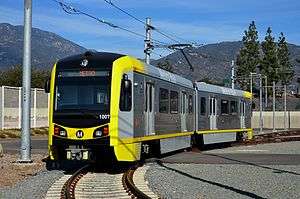Kinkisharyo P3010
| Kinkisharyo P3010 | |
|---|---|
 | |
| Manufacturer | Kinkisharyo |
| Assembly | Palmdale, California |
| Built at | Osaka, Japan |
| Entered service | 2016-present |
| Number built | 235 |
| Fleet numbers | 1001-1235 |
| Capacity | 68 seats |
| Operator(s) | Los Angeles County Metropolitan Transportation Authority |
| Line(s) served |
|
| Specifications | |
| Car body construction | Stainless steel and LAHT composite |
| Car length | 89 feet (27 m) |
| Width | 8.7 ft (2.7 m) |
| Height | 12.5 feet (3.8 m) |
| Floor height | 39 inches (990 mm) |
| Low-floor | No |
| Entry | Level with platform |
| Doors | 8 (4 per side) |
| Articulated sections | 1 |
| Wheel diameter | 28 inches (710 mm) |
| Wheelbase | 7.06 feet (2.15 m) |
| Maximum speed | 65 mph (105 km/h) |
| Weight | 99,000 pounds (45,000 kg) |
| Acceleration | 3 mph/s (4.4 ft/s2; 1.3 m/s2) |
| Deceleration | 3.5 mph/s (5.1 ft/s2; 1.6 m/s2) |
| Train heating | Yes |
| Current collection method | Pantograph |
| Braking system(s) | Pneumatic |
| Safety system(s) | Automatic Train Control, Emergency brakes |
| Headlight type | Light-emitting diode |
| Track gauge | 4 ft 8 1⁄2 in (1,435 mm) standard gauge |
| Notes | |
| [1] | |
The Kinkisharyo P3010 is an articulated light rail car used on the Los Angeles County Metro Rail system. It was manufactured by Kinkisharyo and is used on all of Metro's light rail lines.[2] The trains feature automatic train control, air conditioning, emergency intercoms, wheelchair spaces and emergency braking.
History of the contract
AnsaldoBreda delivered 50 P2550 LRVs to Metro between 2006 and 2011 for use on the newly expanded Gold Line. Delivery of the vehicles was approximately three years behind schedule, and Metro claimed they were overweight; thus, the agency chose not to exercise their option to purchase more beyond this initially contracted order.[3]
However, with multiple light rail lines under construction or in planning and the P865s approaching their end of life, Metro anticipated a substantial need for LRVs and thus requested bids for a new contract, for vehicles which were dubbed the P3010 series. The base P3010 contract order was for 78 cars: 63 cars for the Expo and Blue lines, and 15 cars for the Gold Line Foothill Extension. (Phase 1 of the Expo Line used P865 cars from the existing fleet.) Metro completed a contract on April 30, 2012,[4] with delivery of the first LRV projected for 30 months later, in 2014. The contract included options for an additional 157 cars.[5]
Metro awarded the contract for the first 78 cars to Kinki Sharyo for $299 million. The remaining cars are split into four options with 28, 39, 21 and 69, respectively. If all the options are exercised, the number of LRVs would total 235, valued at a total $890 million.[6][7]
On July 25, 2013, Metro exercised two options (69 + 28) totaling 97 additional cars for $396.7 million. This brought the total of ordered cars to 175. As part of the option, Kinkisharyo, the El Segundo-based U.S. arm of Kinki Sharyo Co. Ltd. of Osaka, announced in December 2014 that they would retrofit an existing space in Palmdale to build the vehicles.[8] Final assembly work was being performed in hangar space the company leased in Palmdale from Los Angeles World Airports.[9] The first car was delivered to Metro in October 2014 for testing before series production begins.[10]
The cars began entering service in early 2016, though many were still in the testing stage when the Expo Line and Gold Line extensions opened that year, resulting in longer-than-expected headways and some crush loads.[11] By October 2016, four LRVs were being delivered per month.[12] In June 2017, P3010s began to be rolled out on the Blue Line, allowing Metro to begin phasing out the P865s.[13] At the end of 2017, some of the P3010s from the Blue Line were routed for Green Line service using the Willowbrook spur and pocket track to transfer between the two lines.
References
- ↑ "Kinkisharyo P3010 Technical Data" (PDF). Kinkisharyo. Retrieved 6 March 2017.
- ↑ Hymon, Steve (1 May 2017). "New Kinkisharyo rail cars slated to roll on Blue Line on Monday". The Source. Retrieved 1 May 2017.
- ↑ "January 6, 2010 - Agenda - Technical Advisory Committee" (PDF). Los Angeles County Metropolitan Transportation Authority. January 6, 2010. Retrieved 2013-09-24.
- ↑ "Special Board Meeting April 30, 2012 - Subject: Light Rail Vehicle Procurement" (PDF). Los Angeles County Metropolitan Transportation Authority. April 30, 2012. Retrieved 2014-04-20.
- ↑ "Light rail vehicle procurement" (PDF). Los Angeles County Metropolitan Transportation Authority. June 17, 2010. Retrieved 2013-09-24.
- ↑
Sam Hudes (2016-10-09). "As TTC's new streetcars lag behind, Detroit and L.A. stay on track". Retrieved 2016-10-11.
In August 2012, the Los Angeles County Metropolitan Transportation Authority chose Japanese firm Kinkisharyo International to produce its new fleet of light rail vehicles, in part due to the company’s reputation of delivering on time.
- ↑ "Los Angeles to order up to 235 light rail vehicles". Railway Gazette. DVV Media Group GmbH. May 1, 2012. Retrieved 2013-09-24.
- ↑ Nelson, Laura J. (November 26, 2014) "Japanese firm plans to build light-rail cars in L.A. area after all" Los Angeles Times
- ↑ Madler, Mark (October 20, 2014) "Update: Kinkisharyo Delivers Rail Car Amid Dispute" San Fernando Valley Business Journal
- ↑ "Los Angeles takes delivery of P3010 light rail vehicle". Railway Gazette. DVV Media Group GmbH. October 20, 2014. Retrieved 2014-11-26.
- ↑ http://thesource.metro.net/2016/04/05/are-we-all-going-to-be-sardines-from-now-on-lets-talk-about-crowding-on-the-gold-line-and-expo-line/
- ↑ http://www.nbclosangeles.com/news/local/More-Cars-to-Be-Added-to-Metro-Expo-Line-398239211.html
- ↑ https://lbpost.com/place/transit/2000011089-metro-says-goodbye-to-old-blue-line-rail-cars-after-27-years-of-service